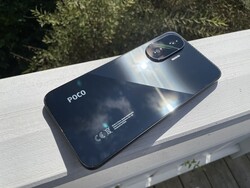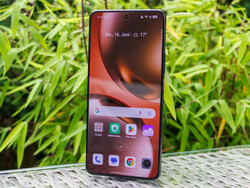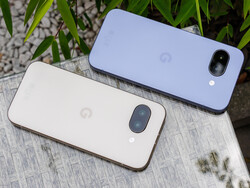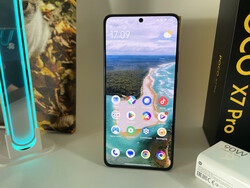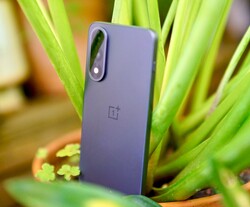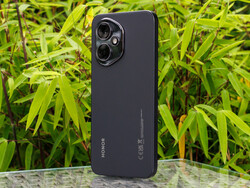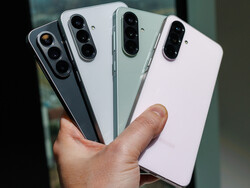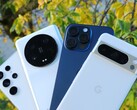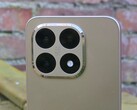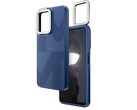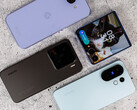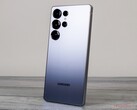
Ranking: Best smartphones for under 500 dollars/euros
November 2025 update.
A few years ago, high-end smartphones sold for under 600 dollars/euros. Now, most flagships cost way more than 1,000 euros, leaving the 500-euro range to mid-range models and aging flagships. Still, while not showcasing any exciting new technology, these products can be very strong options punching above their weight.Daniel Schmidt (translated by DeepL) Published 🇩🇪 🇳🇱 ...
Positioned between the affordable lower mid-range and premium high-end products, mid-range smartphones are meant for buyers who don’t want to splash on a flagship but still seek fast performance, quality cameras, and a premium build.
In the sub-$500/€500 range (based on current prices), previous-year high-end models are available at times. These can be compelling alternatives, often delivering strong specifications and performance.
Best mid-range smartphones to buy in December 2025
Image | Model / Review | Price | Weight | Drive | Display | Screen / Body |
|---|---|---|---|---|---|---|
| Xiaomi Poco F7 Qualcomm Snapdragon 8s Gen 4 SM8735 ⎘ Qualcomm Adreno 825 ⎘ 12 GB Memory, 512 GB | Amazon: 1. $539.99 XIAOMI Poco F7 PRO 5G + 4G L... 2. $11.99 Ibywind for Xiaomi Poco F7 5... 3. $338.00 XIAOMI Poco X7 PRO 5G + 4G L... | 215.7 g | 512 GB UFS 4.1 Flash | 6.83" 2772x1280 447 PPI AMOLED | 94 % | |
| Xiaomi 15T MediaTek Dimensity 8400 ⎘ ARM Mali-G720 MP7 ⎘ 12 GB Memory, 512 GB | Amazon: 1. $11.99 Ibywind for Xiaomi 15T Pro 5... 2. $6.59 Anoowkoa 3 Pack Designed for... 3. $7.99 Fhyeugfy for Xiaomi 15T Pro ... List Price: 650€ | 194 g | 512 GB UFS 4.1 Flash | 6.83" 2772x1280 447 PPI AMOLED | 90 % | |
| Realme GT 7 Mediatek Dimensity 9400e ⎘ ARM Immortalis-G720 MP12 ⎘ 12 GB Memory, 512 GB | Amazon: 1. $11.99 Ibywind For Realme GT 7/GT 7... 2. $8.99 Suttkue for Realme GT 7 Scre... 3. $11.99 Ibywind for Realme GT 7 Pro ... | 206 g | 512 GB UFS 4.0 Flash | 6.78" 2780x1264 450 PPI OLED | 90 % | |
| Motorola Edge 60 Pro MediaTek Dimensity 8350 ⎘ ARM Mali-G615 MP6 ⎘ 12 GB Memory, 512 GB | Amazon: 1. $11.99 Ibywind For Motorola Edge 60... 2. $6.98 Natbok 2 Pack 3D Compatible ... 3. $8.88 LXEEOLX [2 Pack Hydrogel Scr... List Price: 600 Euro | 186 g | 512 GB UFS 4.0 Flash | 6.67" 2712x1220 446 PPI P-OLED | 96.5 % | |
| Google Pixel 9a Google Tensor G4 ⎘ ARM Mali-G715 MP7 ⎘ 8 GB Memory, 128 GB | Amazon: 1. $466.50 Google Pixel 9a with Gemini ... 2. $7.99 Supershieldz (3 Pack) Design... 3. $9.84 Ferilinso 3 Pack Privacy Scr... List Price: 549€ | 185.9 g | 128 GB UFS 3.1 Flash | 6.30" 2424x1080 421 PPI pOLED | 84 % | |
| Xiaomi Poco X7 Pro MediaTek Dimensity 8400 ⎘ ARM Mali-G720 MP7 ⎘ 12 GB Memory, 512 GB | Amazon: 1. $338.00 XIAOMI Poco X7 PRO 5G + 4G L... 2. $332.50 XIAOMI Poco X7 PRO 5G + 4G L... 3. $347.00 XIAOMI Poco X7 PRO 5G + 4G L... List Price: 430€ | 198 g | 512 GB UFS 4.0 Flash | 6.67" 2712x1220 446 PPI AMOLED | 89 % | |
| OnePlus Nord 5 Qualcomm Snapdragon 8s Gen 3 ⎘ Qualcomm Adreno 735 ⎘ 8 GB Memory, 256 GB | Amazon: 1. $6.99 iCsapr [4 Pack Glass Screen ... 2. $5.99 Supershieldz (2 Pack) Design... 3. $13.01 OtterBox OnePlus Nord N200 5... List Price: 449€ | 211 g | 256 GB UFS 3.1 Flash | 6.83" 2800x1272 450 PPI AMOLED | 90 % | |
| Honor 400 Qualcomm Snapdragon 7 Gen 3 ⎘ Qualcomm Adreno 720 ⎘ 8 GB Memory, 512 GB | Amazon: 1. $11.99 Ibywind for Honor 400 5G Scr... 2. $4.99 Mr.Shield Screen Protector c... 3. $11.99 Ibywind For Honor 400 Pro 5G... List Price: 550€ | 184 g | 512 GB UFS 3.1 Flash | 6.55" 2736x1264 460 PPI OLED | 90 % | |
| Samsung Galaxy A56 5G Samsung Exynos 1580 ⎘ Samsung Xclipse 540 ⎘ 8 GB Memory, 128 GB | Amazon: 1. $359.00 Samsung Galaxy A56 5G 2025 |... 2. $349.99 Samsung Galaxy A56 5G 2025 |... 3. $399.99 Samsung Galaxy A56 5G Cell P... List Price: 479€ | 198 g | 128 GB UFS 3.1 Flash | 6.70" 2340x1080 385 PPI Super AMOLED | 88 % | |
| Nothing Phone (3a) Pro Qualcomm Snapdragon 7s Gen 3 ⎘ Qualcomm Adreno 810 ⎘ 12 GB Memory | Amazon: 1. $6.99 JETech Screen Protector for ... 2. $858.41 Nothing Phone (3) Cell Phone... 3. $4.99 Fhyeugfy for Nothing Phone (... | 211 g | 6.77" 2392x1080 388 PPI AMOLED | 88 % |
Note: We transitioned to a new rating system in June 2024. In the updated v8 rating system, certain criteria were adjusted to reflect the latest hardware developments, new rating factors were introduced, and some measurement techniques were updated. As a result, v8 ratings are slightly lower than v7 ratings and are not directly comparable to previous versions. More details on v8 can be found here.
1st place - Xiaomi Poco F7
The Poco F7 has a 6.83-inch AMOLED display that gets very bright and features high-frequency PWM dimming. It is powered by a fast Snapdragon 8s Gen 4 with 12 GB of RAM. The camera setup offers a 50-MP lens and an additional ultra-wide-angle sensor commanding 8 MP. As an important highlight, the model's 6,500-mAh battery is both strong and chargeable quickly at 90 watts. The Poco F7 is also IP68 certified.
Xiaomi's Poco F7 is a powerful, enduring device with few omissions compromises that may be a deal-breaker to some.
Missing here are eSIM support and 6-GHz Wi-Fi, and a fast USB-C 3.0/3.1 port. Only the older 2.0 spec is available. Still, the F7 is a very solid smartphone overall, sold at a fair price.
2nd place - Xiaomi 15T
The 15T is a convincing price-performance hit. Its large and very bright OLED display with 120 Hz, the latest Leica camera and solid runtimes are all very impressive. The multi-year update guarantee is also praiseworthy. The plastic back as well as frame might not be up to everybody's liking, as they reveal this isn't a truly premium product.
Xiaomi's 15T is a strong mid-range all-rounder that's not free of compromises.
The Mediatek Dimensity 8400 SoC ensures decent mid-range performance, but falls short in comparisons with higher-end offerings. USB 2.0 (not 3.0+) and the lack of wireless charging mean extra features aren't plentiful, and the camera only delivers top performance in daylight, faring much worse in low light and when zooming in is required. HyperOS looks appealing enough, while four major Android updates are solid, even if Samsung and Google offer more.
3rd place - realme GT 7
The GT 7 is as a strong contender with plenty of AI power. We appreciate its high-quality casing with aluminum frame, Gorilla Glass 7i and IP69 certification, even if the gaps are a bit uneven. The phone's OLED display (6.78 inches, 120 Hz) offers vibrant colors and short response times, but does not achieve the promised peak brightness and has PWM flickering. The Dimensity 9400e SoC delivers high everyday and gaming performance, but gets warm under load.
The realme GT 7 impresses as a powerful mid-range smartphone with AI functions, strong battery and a good price-performance ratio.
The 50-MP camera with OIS takes good photos in daylight, but is weaker in the dark. There are AI functions such as "AI Planner" complementing the Android 15-based realme UI 6.0, and the brand promises four years of OS updates plus six years of security patches. The 7,000-mAh battery with 120 W fast charging and the solid speaker performance are two more features worth highlighting.
4th place - Motorola Edge 60 Pro
The Edge 60 Pro is a slim, lightweight curved smartphone with high-quality build and pleasant feel. It weighs just 186 g and has an elegant visual design with a leather/textile look and IP68/IP69 certification. The 6.67-inch POLED display impresses with its high resolution, 120-Hz frame rate and extreme brightness of over 4,000 nits. In charge of everything performance is MediaTek's Dimensity 8350, paired with 12 GB of RAM and 512-GB UFS 4.0 storage.
Motorola's Edge 60 Pro is mid-range smartphone with impressive features and talents, such as a bright curved display, powerful camera, outstanding battery life and fair price.
Its triple rear camera setup includes a 50-MP main sensor, a 50-MP ultra-wide-angle one and also a 10-MP telephoto lens with 3x optical zoom. Particularly impressive is its daylight image quality.
In terms of features, the device does not skimp on modern standards: Wi-Fi 6E, eSIM and numerous Bluetooth codecs are all there, albeit a micro-SD card slot is absent. A battery with 6,000 mAh guarantees outstanding runtimes. Charging is quick with 90 W, although no charger is included in the box. Updates are guaranteed until 2029; that means 3 Android version updates and 4 years of security patches.
5th place - Google Pixel 9a
In our testing, the Pixel 9a proved to be a successful mid-range smartphone with excellent battery life and a compact body. It has a 6.3-inch pOLED display with a refresh rate of up to 120 Hz, which has good brightness but is somewhat unevenly lit. The device is IP68-certified and therefore protected against water and dust.
The Pixel has a lot to offer with only a few (bearable) weaknesses, especially considering the comparatively low price.
The Tensor G4 processor powers the whole deal, with 8 GB of RAM and 128 or 256 GB of UFS 3.1 storage at its disposal. Day-to-day performance is very good, but there is noticeable throttling under prolonged high loads. Thanks to pixel binning, the main camera with 48 megapixels delivers sharp and color-balanced images, even in difficult lighting conditions.
Other features include dual SIM with eSIM support, Wi-Fi 6E and a fresh enough Bluetooth version, NFC and a reliable fingerprint sensor in the display. The phone's stereo speakers are loud, but sound pretty bad at higher volumes.
6th place - Xiaomi Poco X7 Pro
The Poco X7 Pro is a powerful smartphone that packs a number of impressive features at an attractive price. Equipped with MediaTek's Dimensity 8400 Ultra processor, it delivers strong performance for both everyday tasks and gaming. Its 6.7-inch OLED display boasts a resolution of 2,712 x 1,220 pixels, a refresh rate of up to 120 Hz, and a peak brightness of 3,200 cd/m².
The X7 Pro offers excellent value thanks to its good performance, high-quality display, and solid battery life, though it has some drawbacks, particularly in the camera department. There is also no wireless charging here.
Its dual rear camera includes a 50-megapixel primary sensor with optical image stabilization and an 8-megapixel ultra-wide-angle camera. While the main sensor delivers good results in daylight, it struggles with zoom and wide-angle shots. The 6,000-mAh battery gives the user over 16 hours of use, and with 90-watt fast charging supported, it can be fully replenished in about an hour - however, wireless charging is not available.
7th place - OnePlus Nord 5
The Nord 5 comes with a solid set of features for the price and conveys a high-quality feel despite its plastic casing. Its visual design has become simpler. The model offers IP65 protection against dust and splashes, but is relatively heavy at 211 grams. its 6.83-inch AMOLED display impresses with 144 Hz and high brightness, but there is the issue of flickering at low brightness. The Snapdragon 8s Gen 3 provides a sizeable power bump, complemented by up to 12 GB of RAM and 512 GB of storage, although the storage performance lags behind the predecessor model. Wi-Fi 6 is onboard, but 6-GHz frequency support is missing.
The Nord 5 is a solid choice, all things considered.
The model ships with Android 15-based OxygenOS, and OnePlus promises four major updates as well as security patches until 2031. The software is easy to use and unwanted apps can be removed. The 50-megapixel main camera with OIS delivers good results in daylight, but is weaker in low light; the front camera also takes solid photos with 50 MP. One drawback wowth mentioning is that the 1+ smartphone is not eSIM-enabled.
8th place - Honor 400
Honor's 400 shaped up to be a sophisticated mid-range smartphone with an impressive price-performance ratio in our testing. The phone has a 6.55-inch AMOLED display with a resolution of 2,736 x 1,264 pixels, 120-Hz refresh rate and up to 5,000 nits of peak brightness. The display also supports eye protection features such as high-frequency PWM dimming, low blue light mode and a special motion sickness mode.
The 400 left us impressed. This is a modern mid-range model with premium aspirations that deserves praise for its first-class display, powerful camera with AI features, large battery capacity, fast charging and long-term software support.
The casing has a high-quality finish, including a matte back that hardly collects any fingerprints, and a flat frame. This Honor phone also has IP65 certification for moderate protection against dust and splashes of liquids. An infrared blaster is onboard, too.
Other key features include a 200-MP main camera with OIS and a 12-MP ultra-wide-angle camera with macro capability. The front camera has a resolution of 50 MP. Overall, image quality is good here, with AI tricks such as converting photos into short videos, AI zoom and object removal as some extra icing on the cake.
The battery has a capacity of 5,300 mAh and needs less than an hour to go from zero to hero. Please note we are referring to the European version here with the optional 66-W charger.
9th place - Samsung Galaxy A56 5G
The Galaxy A56 5G is a strong upper mid-range contender. It impressed us with its slim and light housing (7.4 mm, 198 g) made of Gorilla Glass Victus+ and aluminum that has IP67 certification, a highly modern visual design and slim display edges. The 6.7-inch Super AMOLED display offers a refresh rate of up to 120 Hz and peak brightness of up to 2,000 cd/m².
The A56 5G delivers a balanced mid-range experience: Elegant looks, bright display, long enough runtimes, years of guaranteed software support and some basic AI features. There are also limitations; those who like optical zoom may not appreciate this Galaxy model. There is no micro-SD card slot here, either.
Its battery has a capacity of 5,000 mAh and supports 45 W wired fast charging for the first time (with only 25 W available on previous-gen models). Runtimes look good to us but wireless charging is still not available. On the software front, the Samsung makes use of Android 15 with One UI 7.0 and some AI features such as circle to search, object eraser and best face for group photos which are features not commonly found on mid-range phones. Samsung also promises 6 years of Android OS updates and security patches.
While there is no micro-SD slot, 6-GHz Wi-Fi or UWB here, dual e-SIM, NFC, Wi-Fi 6 and Bluetooth 5.3 are all available.
10th place - Nothing Phone (3a) Pro
The Phone (3a) Pro has a 6.77-inch AMOLED display with a resolution of 2,392 x 1,080 pixels, a refresh rate of 120 Hz and a peak brightness of up to 3,000 nits. Both the front and back are protected by Panda Glass. The casing is IP64-certified, which is a basic but welcome nonetheless protection against dust and splashes of non-aggressive liquids. The Phone (3a) Pro is powered by a Snapdragon 7s Gen 3, supported by 12 GB of RAM and 256 GB of storage. Its 5,000-mAh battery enables long enough battery life and can be charged via USB-C at up to 50 watts; wireless charging is not supported here.
The Phone 3a Pro is notable for its striking visual design and powerful cameras. Compared to the base (non-Pro) model, it offers perks such as eSIM support and improved rear camera.
Cameras. These include a 50-megapixel main sensor, a 50 megapixel-periscope telephoto camera with triple optical zoom and an 8-megapixel ultra-wide-angle camera. The front camera also offers 50 megapixels. Both the main and telephoto cameras have optical image stabilization.
The Essential Key, an extra button on the right-hand side of the product, is one of its highlight features. Do a short press to take a screenshot, while a long press starts a voice memo recording by default. There is also "Essential Space", an AI-enabled app that organizes and categorizes user data.
Best smartphones for less than 500 dollars/euros: Overview
Measurements
| Xiaomi Poco F7 Adreno 825, SD 8s Gen 4, 512 GB UFS 4.1 Flash | Xiaomi 15T Mali-G720 MP7, Dimensity 8400, 512 GB UFS 4.1 Flash | Realme GT 7 Immortalis-G720 MP12, Dimensity 9400e, 512 GB UFS 4.0 Flash | Motorola Edge 60 Pro Mali-G615 MP6, Dimensity 8350, 512 GB UFS 4.0 Flash | Google Pixel 9a Mali-G715 MP7, Tensor G4, 128 GB UFS 3.1 Flash | Xiaomi Poco X7 Pro Mali-G720 MP7, Dimensity 8400, 512 GB UFS 4.0 Flash | OnePlus Nord 5 Adreno 735, SD 8s Gen 3, 256 GB UFS 3.1 Flash | Honor 400 Adreno 720, SD 7 Gen 3, 512 GB UFS 3.1 Flash | Samsung Galaxy A56 5G Xclipse 540, Exynos 1580, 128 GB UFS 3.1 Flash | Nothing Phone (3a) Pro Adreno 810, SD 7s Gen 3 | |
|---|---|---|---|---|---|---|---|---|---|---|
| Response Times | ||||||||||
| Response Time Grey 50% / Grey 80% * (ms) | 1.06 ? | 1.2 ? | 0.96 ? | 18.6 ? | 0.93 ? | 1.69 ? | 1.4 ? | 1 ? | 1.15 ? | 0.66 ? |
| Response Time Black / White * (ms) | 1.1 ? | 1.28 ? | 1.23 ? | 1.8 ? | 0.81 ? | 1.43 ? | 17.7 ? | 0.96 ? | 1.2 ? | 1.23 ? |
| PWM Frequency (Hz) | 120 | 120 | 90 | 715.7 | 240 | 120 | 119 | 60 | 120 | 90 |
| PWM Amplitude * (%) | 16.95 | 17.05 | 16.76 | 75 | 12.82 | 14.29 | 9 | 16.26 | 14.29 | 13.25 |
| Screen | ||||||||||
| Brightness middle (cd/m²) | 1616 | 1070 | 1519 | 1099 | 1978 | 1034 | 1162 | 1605 | 1184 | 1318 |
| Brightness (cd/m²) | 1637 | 1079 | 1530 | 1073 | 1775 | 1041 | 1130 | 1607 | 1179 | 1306 |
| Brightness Distribution (%) | 95 | 94 | 97 | 91 | 76 | 97 | 95 | 96 | 99 | 98 |
| Black Level * (cd/m²) | ||||||||||
| Colorchecker dE 2000 * | 1.1 | 1.5 | 1 | 1.25 | 1.1 | 1 | 3.24 | 0.7 | 1.7 | 1.5 |
| Colorchecker dE 2000 max. * | 2.8 | 3.9 | 1.7 | 1.68 | 3 | 2.2 | 6.54 | 1.5 | 3.2 | 2.9 |
| Greyscale dE 2000 * | 2.2 | 2.5 | 1.1 | 1.4 | 2.2 | 1.4 | 1.7 | 1.1 | 2.4 | 2.3 |
| Gamma | 2.24 98% | 2.24 98% | 2.22 99% | 2.031 108% | 2.22 99% | 2.22 99% | 2.212 99% | 2.24 98% | 2.12 104% | 2.26 97% |
| CCT | 6639 98% | 6648 98% | 6661 98% | 6403 102% | 6622 98% | 6553 99% | 6788 96% | 6422 101% | 6544 99% | 6819 95% |
| Heat | ||||||||||
| Maximum Upper Side * (°C) | 45.4 | 42.8 | 47.3 | 54.7 | 43 | 44.5 | 51.3 | 44.7 | 48.5 | 43.3 |
| Maximum Bottom * (°C) | 45.1 | 43.5 | 48.3 | 58.4 | 43.4 | 43.5 | 50.7 | 43.4 | 49 | 39.7 |
| Idle Upper Side * (°C) | 26.4 | 25.3 | 26.4 | 28.2 | 31.2 | 26.6 | 32.5 | 30.9 | 28.1 | 27.6 |
| Idle Bottom * (°C) | 25.5 | 25.1 | 26.1 | 28.5 | 29 | 26.1 | 31.7 | 28.3 | 27.1 | 27.1 |
| Battery runtime | ||||||||||
| Reader / Idle (h) | 40.8 | 26.8 | 44.8 | 33 | 35.4 | 52.9 | ||||
| WiFi v1.3 (h) | 22.7 | 17.2 | 23.8 | 22.4 | 21.2 | 19.7 | 17.2 | 20 | 20 | 19.8 |
| Load (h) | 3.4 | 4.5 | 4 | 4.3 | 4.5 | 3.6 |
* ... smaller is better
Benchmark scores
| GFXBench | |
| 1920x1080 Aztec Ruins Normal Tier Offscreen (sort by value) | |
| Xiaomi Poco F7 | |
| Xiaomi 15T | |
| Realme GT 7 | |
| Motorola Edge 60 Pro | |
| Google Pixel 9a | |
| Xiaomi Poco X7 Pro | |
| OnePlus Nord 5 | |
| Honor 400 | |
| Samsung Galaxy A56 5G | |
| Nothing Phone (3a) Pro | |
| on screen Aztec Ruins Normal Tier Onscreen (sort by value) | |
| Xiaomi Poco F7 | |
| Xiaomi 15T | |
| Realme GT 7 | |
| Motorola Edge 60 Pro | |
| Google Pixel 9a | |
| Xiaomi Poco X7 Pro | |
| OnePlus Nord 5 | |
| Honor 400 | |
| Samsung Galaxy A56 5G | |
| Nothing Phone (3a) Pro | |
| 2560x1440 Aztec Ruins High Tier Offscreen (sort by value) | |
| Xiaomi Poco F7 | |
| Xiaomi 15T | |
| Realme GT 7 | |
| Motorola Edge 60 Pro | |
| Google Pixel 9a | |
| Xiaomi Poco X7 Pro | |
| OnePlus Nord 5 | |
| Honor 400 | |
| Samsung Galaxy A56 5G | |
| Nothing Phone (3a) Pro | |
| on screen Aztec Ruins High Tier Onscreen (sort by value) | |
| Xiaomi Poco F7 | |
| Xiaomi 15T | |
| Realme GT 7 | |
| Motorola Edge 60 Pro | |
| Google Pixel 9a | |
| Xiaomi Poco X7 Pro | |
| OnePlus Nord 5 | |
| Honor 400 | |
| Samsung Galaxy A56 5G | |
| Nothing Phone (3a) Pro | |
| Antutu v10 - Total Score (sort by value) | |
| Xiaomi Poco F7 | |
| Xiaomi 15T | |
| Realme GT 7 | |
| Motorola Edge 60 Pro | |
| Google Pixel 9a | |
| Xiaomi Poco X7 Pro | |
| OnePlus Nord 5 | |
| Samsung Galaxy A56 5G | |
| Nothing Phone (3a) Pro | |
| CrossMark - Overall (sort by value) | |
| Xiaomi Poco F7 | |
| Xiaomi 15T | |
| Realme GT 7 | |
| Google Pixel 9a | |
| Xiaomi Poco X7 Pro | |
| Honor 400 | |
| Samsung Galaxy A56 5G | |
| Nothing Phone (3a) Pro | |
| Octane V2 - Total Score (sort by value) | |
| Xiaomi Poco F7 | |
| Xiaomi 15T | |
| Realme GT 7 | |
| Motorola Edge 60 Pro | |
| Google Pixel 9a | |
| Xiaomi Poco X7 Pro | |
| OnePlus Nord 5 | |
| Honor 400 | |
| Samsung Galaxy A56 5G | |
| Nothing Phone (3a) Pro | |
| PUBG Mobile - HD (sort by value) | |
| Xiaomi Poco F7 | |
| Xiaomi 15T | |
| Motorola Edge 60 Pro | |
| Google Pixel 9a | |
| Xiaomi Poco X7 Pro | |
| Samsung Galaxy A56 5G | |













